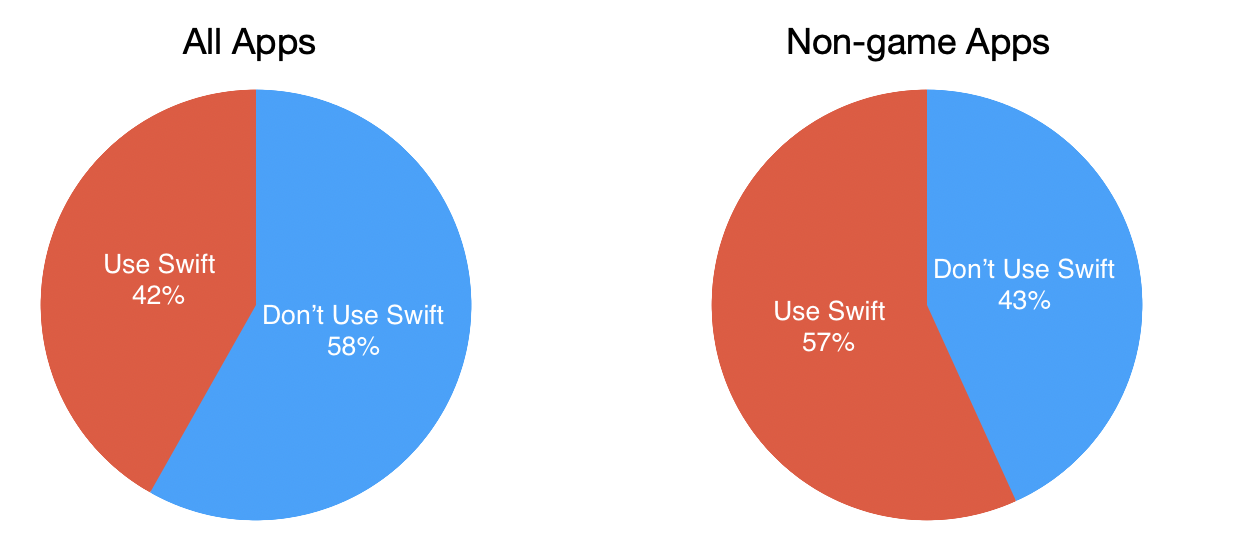Three years ago, I read a blog post by Ryan Olsen where he explored how many of the top 100 apps on the app store were using Swift. He was surprised that at the time, only 11% of the top 100 apps were using Swift (I wasn’t).
I thought it would be interesting to revisit this in early 2019. Swift has been out for going on 5 years now, Swift 5 will be released soon, and my perception is that Swift has been broadly adopted across the iOS development community. But, what do the numbers say?
I downloaded the top 110 free apps on the app store on January 15, 2019. I decrypted them, then wrote a script that does some simple analysis of their contents to determine whether or not they’re using Swift, and roughly how much of the app is written in Swift.
Results
According to this analysis, of the top 110 apps on the app store on January 15, 2019, 42% are using Swift, while 58% are not. If only the 79 non-game apps are considered, the results are that 57% are using Swift, while 43% are not.

Interestingly, of the 31 games, none are using Swift at all. My guess is that most if not all of them are written using Unity or another cross-platform game engine, and therefore don’t have much if any iOS-specific code. I did look at a few of them myself and noticed that while the games I analyzed do have Objective-C classes, they seem to be mostly code from various analytics and social media frameworks, not code that was actually written specifically for the game itself.
Methodology
The apps were analyzed using a Python script that I wrote. You can find the script in this GitHub repo. A few notes about the way the script works:
In order for an app to be considered to “use Swift”, it must include libswiftCore.dylib in its Frameworks folder, and it must have at least one Objective-C compatible Swift class in the main executable. Some apps don’t use Swift in the main executable but include dynamically linked frameworks that use Swift. For this analysis, those apps are not counted as using Swift, because I wanted to get an idea of how many apps themselves were being developed in Swift.
However, this way of doing analysis is not perfect. For one thing, it will still count an app as using Swift if that app includes a staticly linked Swift library, even if the app’s own code doesn’t use Swift. There’s no foolproof way (that I know of) to automate figuring that out.
For apps using Swift, the script also tries to determine the percentage of each app’s main executable that is written in Swift. It determines the percentage of the app written in Swift by finding all the Objective-C exposed classes, and counting those written in Swift vs. those written in Objective-C. Again, this is imperfect because it doesn’t include Swift types that are not @objc classes. But it does give you a rough ballpark figure for how heavily each app uses Swift. The values here range from a minimum of 1% for the Google Drive app, up to a maximum of 80% for the Walmart app. The average percentage of each Swift-using app written in Swift is 34%.
The determination of whether an app was a game or not was made by hand by me, and is by nature somewhat subjective. For example, I didn’t consider Bitmoji or TikTok games, despite them both being fun entertainment apps.
Takeaway
In the past 3 years, Swift has gone from being used in a small minority of the most popular apps to being used in roughly half of them, which is a huge increase and shows how well Apple has done with introducing a new language. However, even for apps using Swift, they continue to use Objective-C fairly heavily. So, Objective-C is far from dead. Games continue to be written using tools that allow for cross-platform deployment, and are therefore written in languages other than Objective-C and Swift.
Data
You can find the raw data I generated in this GitHub Gist. If you do your own analysis that turns up other interesting insights, I’d love to hear about it!